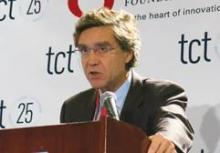SAN FRANCISCO – Treating bare metal stent in-stent restenosis using a drug-eluting stent yielded a significantly larger minimal lumen diameter 1 year later, compared with treatment using a drug-eluting balloon in a study of 189 patients.
A second-generation everolimus-eluting stent bested a paclitaxel-eluting balloon in the primary outcome of the prospective, randomized trial after adjusting for age, smoking history, stenosis, and the presence of diabetes.
The video associated with this article is no longer available on this site. Please view all of our videos on the MDedge YouTube channel.
The in-segment minimal lumen diameter was 2.36 mm for the 94 patients in the stent group and 2.01 mm for the 95 patients in the balloon group. The in-lesion minimal lumen diameter was 2.44 mm in the stent group and 2.03 mm in the balloon group. Both differences were statistically significant, Dr. Fernando Alfonso and his associates reported at the Transcatheter Cardiovascular Therapeutics annual meeting.
The rate of restenosis (greater than 50% lumen diameter narrowing) at the 1-year follow-up point was very low in both groups: 4.7% in the stent group and 9.5% in the balloon group. That difference was not statistically significant between groups.
Median in-segment late loss (the difference between minimal lumen diameter at completion of the procedure and at 1 year follow-up) was strikingly small and did not differ significantly between groups, reported Dr. Alfonso, an interventional cardiologist at Hospital Universitario Clinico San Carlos, Madrid.
Late loss in the stent group was 0.04 mm and in the balloon group was 0.14 mm, he added.
Rates of major adverse cardiac events were similar between groups: 94% in the stent group and 91% in the balloon group died of cardiac-related causes or had an MI or target vessel revascularization within a year of treatment. Rates of major adverse events also were statistically similar between groups in the RIBS V (Restenosis Intra-Stent of Bare Metal Stents: Paclitaxel-Eluting Balloon vs. Everolimus-Eluting Stent) trial.
A total of 6% of patients in the stent group and 12% in the balloon group developed a major adverse event; these rates were statistically similar. Four patients in the balloon group and none in the stent group died; three of the deaths were from noncardiac causes. Four patients in the stent group and three in the balloon group had an acute MI. Two patients in the stent group and six in the balloon group underwent target vessel revascularization. (Some patients had more than one adverse event.)
"In patients with bare metal stent in-stent restenosis, both drug-eluting balloons and everolimus-eluting stents provide excellent clinical outcomes" and excellent angiographic findings with very low late loss and low restenosis rates, Dr. Alfonso said at the meeting, cosponsored by the American College of Cardiology. "Further studies with larger numbers of patients and longer follow-up are required to elucidate if these superior late angiographic findings may eventually translate into a clinical benefit." In the meantime, drug-eluting balloons appear to offer "a very good alternative" for patients who may not be good candidates for drug-eluting stents, he said.
The study included patients aged 20-85 years at 25 Spanish centers who had more than 50% stenosis in a bare metal stent and angina or silent ischemia. In-segment quantitative coronary angiography measurements were similar between groups at baseline: the reference diameter was 2.63 mm in the stent group and 2.62 mm in the balloon group, and the lesion length was 13.8 mm in the stent group and 13.7 mm in the balloon group.
Patients who were randomized in 2010-2012 to receive Xience Prime everolimus-eluting stents (by Abbott Vascular) were significantly younger, compared with those who got SeQuent Please paclitaxel-eluting balloons (by B. Braun Surgical) – 64 vs. 67 years, respectively. Those in the stent group also were more likely to have ever smoked (75% vs. 59%, respectively). Eight patients in the balloon group eventually crossed over to stent implantation, and no patients in the stent group crossed over to balloons.
One-year follow-up was available for 170 patients (92%), and results were calculated in intent-to-treat analyses.
Dr. Alfonso reported having no financial disclosures.
On Twitter @sherryboschert


